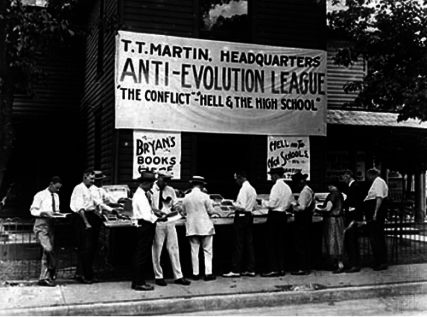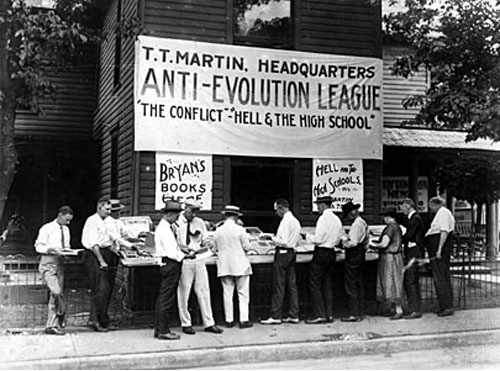Ninety years ago today, the Scopes trial came to an end with the conviction of John Scopes for teaching human evolution in the public schools. The Scopes trial is a watershed moment in the history of American religion—critics of evolution won the trial but lost credibility among the public (or so the story goes).
The trial was also the beginning of a new concept: The Bible Belt.
The region now known as the Bible Belt had its start with the missionary movements by Baptists and Methodists in the 1800s. As many Protestant denominations moved in a modernist direction in the late 1800s, churches in the southern states and parts of the midwest remained skeptical of scientific advances, liberal theology, and church hierarchies.

Anti-Evolution League, at the Scopes Trial, Dayton Tennessee. From Literary Digest, July 25, 1925. From Mike Licht via Flickr creative commons. https://www.flickr.com/photos/notionscapital/9650462984/
The Scopes trial brought this conflict into high relief. And there to chronicle the trial was H. L. Mencken from Baltimore. Mencken was a quick-witted critic who wrote stories about the trial that were more satire than journalism.
Mencken is the one who dubbed the trial the “Monkey Trial.” He is also the one who coined the moniker “Bible Belt.” Mencken first wrote about the Bible Belt in 1924, but the popularity of the term took off with the Scopes trial and its aftermath.
Mencken was no fan of religion, and his creation of the “Bible Belt” was meant as a term of derision. Those living in the Bible Belt, however, found the term complimentary—theirs was the land of the Bible. For both those within and outside the Belt, the term accurately captured the essence of the region.
Don’t miss any more posts from the Corner of Church & State. Click the red subscribe button in the right hand column. Follow @TobinGrant on Twitter and on the Corner of Church & State Facebook page.





